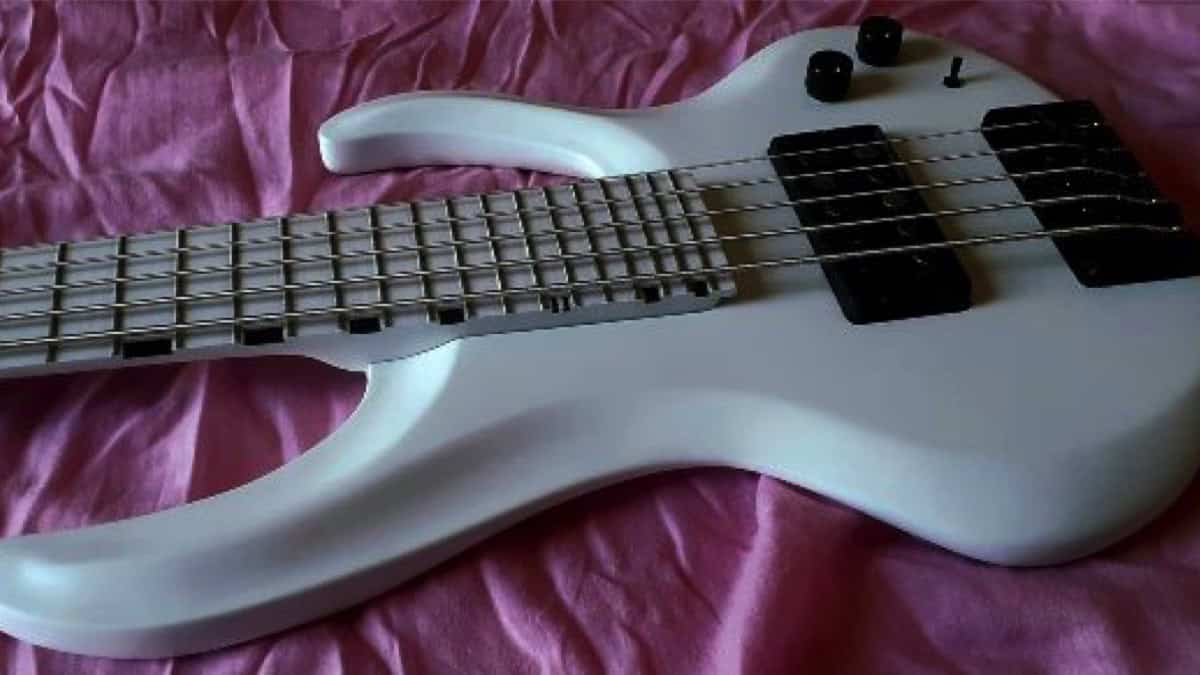Latest
Dynamics vs. Sound… Knobs vs. Hands

 Dynamics vs. Sound… Knobs vs. Hands… I’m one of those few guys (for better or for worse – hahaha) who chose not to have any potentiometer at all on his instruments…. I’ve been playing like that for almost 14 years, and my main influence for taking that decision was perhaps the great Anthony Jackson.
Dynamics vs. Sound… Knobs vs. Hands… I’m one of those few guys (for better or for worse – hahaha) who chose not to have any potentiometer at all on his instruments…. I’ve been playing like that for almost 14 years, and my main influence for taking that decision was perhaps the great Anthony Jackson.
Attending to my Obsessive Compulsive Disorder, I went beyond that, so I also stopped using a volume pedal as Anthony Jackson still does. My basses are also full passive, so there is not any circuitry in there. I also use very special instrument cables with 10% pure silver content, which are not even made for musical instruments. Those cables cost about $200 dollars per meter… so add up what it costs for two-4 meter cables… luckily the Chilean Audioquest distributor just gives them to me. I also have to add that I set all the amp knobs flat at 12. I’m mentioning all of this because my quest is to look for the purest and cleanest sound possible.
The most important question here is…. why???
I think that the answer is quite simple, and is related to the difference in sound between both options.
Like any regular bassist, I started playing a normal bass with all the potentiometers and active circuitry, but something always bothered me and I couldn’t explain what it was. Finally I came to the conclusion that the thing that bothered me the most was the fact of having to produce any modification on my sound (tone or volume) “while playing” by moving a knob… I found that it was a “not so human” and a very “indirect” way to produce those sound modifications; so to say it… and I want to stress the fact that this is just a personal opinion and a personal option… I’m not the owner of any truth.
But the most important reason for me was not that… Besides the “psychological” facts already mentioned, there was a profound reason that I would say, “I consider far more objective in my opinion”, which is already a sophism — hahaha. This reason is the enormous difference I hear while working the dynamic range with my finger “touch” or my hand instead of doing it with my volume control (which I don’t have). A decreasing in volume has to be accompanied by a difference on the attack of the fingers. A good way to hear this huge difference is to play something and decrease the volume, with the volume knob or the volume pedal, while playing exactly with the same intention, strength and hand position. The volume will decrease, no doubt about it, but if you pay close attention to what you are hearing, there will be something “wrong” (so to say it) in there.
Now try the other option… that’s leaving your knobs and pedals exactly where they are and start decreasing the volume gradually just by plucking the strings softer each time. Go gradually and try to make it look like somebody’s moving down the master volume of your amp. If you work it a lot you’ll get it… and the best thing is that you’ll get a much better result than moving the master volume down while you are playing. Something is going to start making complete sense for your ears and for your overall sensation. Obviously you can do quite the opposite thing, starting from a very soft touch, that means a very low volume, and then starting to increase the intensity of the “touch”.
One of the main advantages of getting use to adjusting all of the dynamics with your hand is the fact that you are able to make those adjustments “note by note”, no matter the speed, something completely impossible to achieve in a proper manner using a volume knob or volume pedal. A really good recommendation to be able to help achieve this purpose is to set little higher volumes on the master volume of the amp, so to have more headroom to work with… I learned that many years ago from the great Gary Willis and it works really fantastic.
What about tone controlling?
Not having filters is the equivalent on a passive bass as leaving the volume and tone potentiometers completely open, or with full “bright” and full volume. On an active bass it is the equivalent of leaving the volume and tone controls on the exact middle of the rotation range of the potentiometers.
That being said, and addressing specifically the tone issue now, let’s imagine we are exactly on the center position of the tone control and we want to adjust our tone increasing the lows… well… just move your right hand a little bit towards the neck and pluck the strings with more “meat” of your fingertips rubbing it a little bit more than usual in order to avoid high transients… or staccatos, which means the same but using a musical term… also, don’t forget to push down the string instead of pulling it… the less the “pulling content” of the right hand fingers while touching the strings, the less treble on the final sound.
On the other hand, if we want to adjust our tone increasing the highs… well… just move your right hand a little bit towards the bridge and pluck the strings with less “meat” of your fingertips, using mostly the very point of your fingertips. Avoid rubbing the strings, and pull them in a more aggressive manner so to be able to increase the transients or staccatos. Also, don’t forget to pull the string a little bit instead of pushing it; the less the “pushing content” of the right hand fingers while touching the strings, the more treble on the final sound. Getting little ‘fret buzzing’ from the strings also adds “highs” to the harmonic content; you do that by pulling and hitting the strings a little harder with the right hand.
On the other hand, if you definitely want a really muffled-muted sound with almost no highs on it. palm mute is the best option to go. I’m sure you know the technique, but don’t think it’s so easy, practice it properly and diligently, be precise and clean and also get more speed from it so to be able to play fast palm muted runs too!
The left hand has also something to say here… if you want a half muted sound not as muted as with the palm mute, just press each note really shortly and softly with the left hand fingertips. That will produce a muted sound with less low frequency content, with less staccato and obviously with a really short duration.
Finally, never forget that one of the most important advantages of not having any filters and knobs on your instrument, is the fact that the harmonic content of the original and “pure” sound of the bass can fully breath untouched… and if you listen really, really carefully, you’ll be able to notice a huge difference.
See you on the next my friends!
Gear News
New Gear: Spector Doug Wimbish USA Custom Series Basses

Spector offers Doug Wimbish USA Custom Series basses…
Spector, a leading authority in bass guitar design, unveils two new Doug Wimbish USA Custom Series basses. Synonymous with bass excellence since 1987, Wimbish collaborated with Spector’s USA Custom Shop to create the DW-4 and DW-5 models, echoing the iconic instruments that have been favored heavily throughout his recording and performing career.
These signature basses faithfully replicate Wimbish’s originals, down to the smallest details like neck contours and nut widths. Customized EMG pickups, developed in collaboration with Wimbish, capture the distinctive sound that has shaped his monumental musical impact. These models invite players to explore the feel and response that have defined Wimbish’s signature style over the years.
Available in 4-string and 5-string versions, each model boasts unique features & finish options. The DW-4 comes in Amber Stain Gloss and Black Stain Gloss options, while the DW-5 offers Dark Blue Stain Gloss and Faded Natural Gloss. Every purchase includes a certificate of authenticity signed by Doug Wimbish. Wimbish comments, “Spector took the time to get every little nuance right, and that to me is dedication and being thoughtful enough to know ‘I want to nail it,’ and they did. I’m able to pick these instruments up for the first time and play them like I’ve already had them for years.”
For more information, visit spectorbass.com/doug-wimbish-usa-signature-series/.
Photo: Doug Wimbish, pictured with the new Spector Doug Wimbish USA Custom Series basses
Bass CDs
New Campaign: Alberto Rigoni, Nemesis Call – Queens Of Strings

Italian bass master and composer ALBERTO RIGONI is thrilled to announce his brand new project “Nemesis Call – Queens Of Strings”.
Nemesis Call – Queens Of Strings features a super talented drummer from Japan (TBA) and tons of female guitarists such as SAKI, Giusy Busetto, Alexandra Zerner (TBC) and many many others (TBA). Furthermore, Alberto has also launched a Fundraising Campaign for the project. 20% of the income will be donated to Lega del Filo d’Oro legadelfilodoro.it/it, an Italian association that helps deaf and blind children!
Alberto shares:
“Hello friends and music lovers! I’m Alberto Rigoni, an Italian composer and.. a BASS GUY! Between 2008 and 2024 I released 13 solo albums, spanning from progressive, rock, ambient to funky and experimental music, which also features contributions from musicians such as keyboard wizard Jordan Rudess (Dream Theater) drummer Gavin Harrison (Porcupine Tree) and Marco Minnemann (the Aristocrats), keyboardist Kevin Moore (ex Dream Theater), singer John Jeff Soto (ex Goran Edman (ex Y. Malmsteen), bassists Nathan East, Stu Hamm (Joe Satriani), Nik West (ex Prince) and many others. I’m also bass player for BAD As, Sunset Groove Society, Kim Bingham, The Italians bands and co-producer of Mistheria’s Vivaldi Metal Project.”
Alberto on the new project Nemesis Call:
“Even if my latest album “Unexpected Lullabies”, dedicated to my newborn Vittoria Parini Rigoni, will be released on June 4th, 2024, when Vittoria came to life I felt the need to compose new music (yes, I really can’t stop!!!!!). This time will be quite challenging because I’m willing to release an instrumental ambient/prog/rock/metal album, that will feature a talented and young drummer (TBA) and tons of female guitarists (that’s why I will call the album “Queens of the Strings”) such as Alexandra Zerner, YOKA and many others (TBA/TBC)). It won’t be easy to manage all such great musicians but I will make it!! Are you ready to face a new prog experience? The album will be released in Digipack CD and in high-quality digital format approximately at the beginning of 2025.”
The Fundraising Campaign:
As an independent artist, Alberto is looking for supporters who can help him reach the budget for the production (recordings, mix, mastering, artwork etc.) of this new album and has started this fundraising campaign that will end successfully on October 15th, 2024.
Get further information about Alberto Rigoni’s new project Nemesis Call Fundraising campaign at albertorigoni.net/nemesiscal
Bass Videos
Artist Update With Bassist Derek Frank

Bassist Derek Frank…
Many of you will remember the last time I chatted with Derek Frank was back in 2017. The main thing that impressed me was how busy Derek was and how he juggled playing with many huge acts.
Now, I am happy to hear that Derek launched a new album last March titled “Origin Story” where he digs deep into his roots and pays homage to Pittsburg.
Join me as we get caught up after all these years and hear the details about the new album, how Derek gets his sound, and his plans for the future.
Photo, Stephen Bradley
Featured Videos:
Visit Online:
www.derekfrank.com
www.instagram.com/derekfrankbass
www.youtube.com/derekfrankbass
www.facebook.com/derekfrankbass
Latest
This Week’s Top 10 Basses on Instagram

Check out our top 10 favorite basses on Instagram this week…
Click to follow Bass Musician on Instagram @bassmusicianmag
FEATURED @foderaguitars @bqwbassguitar @lecomptebass @xvector_basses @vuorensaku_guitars @phdbassguitars @meridian_guitars @sterlingbymusicman @ramabass.ok @overwaterbasses
Gear News
New Gear: Alberto Rigoni Signature Bass, the VPR5 by Gaetano Costanzo!

Alberto Rigoni Signature Bass, the VPR5 by Gaetano Costanzo!
Internationally renowned bassist ALBERTO RIGONI (soloist, BAD AS, Vivaldi Metal Project, TwinSpirits, etc.) is proud to announce the release of his signature bass VPR5 made by renowned Italian luthier Gaetano Costanzo!
The bass is entirely handmade in Italy, without the use of CNC or other machinery, and has rather special features. The VPR is a 5-string bass (but also available as a 4-string) with 30 frets, Seymour Duncan pickups, Music Man Alnico style, passive electronics (volume, tone and a switch to select series/parallel/single-coil mode), alder body, and American maple neck and fingerboard. Gotoh tuners that ensure perfect intonation. The bass is totally painted white (nitro finish) but other colors can be requested. The VPR has a weight of about 2.9 kg and suitable for any genre.
For more information contact Gaetanobass77@gmail.com or visit online at www.instagram.com/gaetanocostanzoluthier or www.facebook.com/GaetanoCostanzoLuthier













